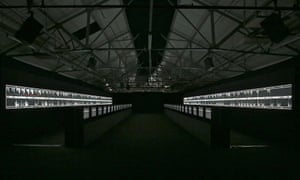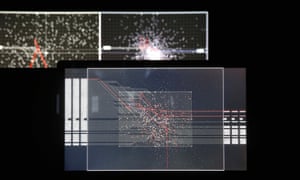Should art respond to science? On this evidence, the answer is simple: no way
Japanese artist Ryoji Ikeda’s installation Supersymmetry is inspired by his residency at Cern – but signifies little more than that physics is weird. Isn’t it time we stopped expecting artists to understand the complexities of science?

Physics – it really does your head in. That seems to be the less than enlightening message the Japanese visual artist and composer Ryoji Ikeda – creator of the massive light beam Spectra that took over the sky in London last year to commemorate the first world war – took from a residency at Cern in Geneva.
Ikeda’s installation Supersymmetry, staged in the darkened uppermost level of a multistorey car park, is apparently what you get when you introduce an artist to the world’s most advanced particle research insitute and its renowned Large Hadron Collider. A lot of sound and light, signifying nothing.
Why does Cern want artists to respond to it anyway? On this evidence they have little to say about advanced science. Ikeda’s noisy, nervous, annoying artwork merely communicates what any layperson might feel if exposed to hardcore physics. This array of beeps, whooshes, dazzling strobes and light pulses basically seems to be rubbing its head and groaning: “Blow me, this is complicated stuff.”
The insight that cutting-edge science is weird is not really an insight. It is also probably not the point of the Large Hadron Collider. In its first experimental season, the largest particle accelerator ever built established the physical existence of a previously hypothetical particle, the Higgs boson. That’s not chaos, but coherent scientific discovery in the empirical tradition of Galileo and Newton.

Ikeda’s title, Supersymmetry, refers to an as yet unproven theory that tries to go beyond the Standard Model of contemporary physics to find the logic of the universe. It implies an idea of harmony and beauty: the clue is in the word “symmetry”. Maybe that harmony is a fantasy, as the Large Hadron Collider has not yet found it. Perhaps, in its defence, Ikeda’s installation is a tragic meditation on the failure of contemporary physics, a foreboding along the lines of Lee Smolin’s book The Trouble with Physics.
I somehow don’t think it’s anything so coherent. As you go into this vast dark space, there are swarms of particles in lightboxes and electro music noises: then strobes randomly break up any pattern of thought you might be having. The next part of the installation is far more impressive, as long parallel rows of screens materialise and vanish, data is visualised then obliterated, and particles leave trails of light in the dark.
It is spectacular, but it doesn’t add up. If the Large Hadron Collider were anything like this it would probably have blown a hole in the universe … as some feared when it was first switched on. Every time anything like sense emerges in the play of digital plasma, it gets broken to pieces by feedback and lightning. This is not a work of art about physics. It is a work of art about how crazy everything is. That’s a trivial misunderstanding of what goes on at Cern, surely.
There’s a giveaway when the pulses are replaced by streaming text: the words flowing across batteries of screens are deliberate nonsense. I see this as the artist’s view of physics, just a different language that makes no sense at all.
Art and science, we feel, should have something to say to each other. But perhaps they speak different languages after all. I don’t speak the language of science too well, either, but I do know one thing: it is concerned with the wonder of nature. There is a depressing lack of wonder in this technically sophisticated but intellectually and emotionally empty art.